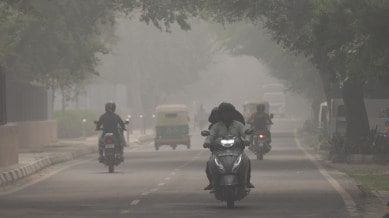Stay updated with the latest - Click here to follow us on Instagram
Mumbai’s AQI plummets a week ahead of Diwali, Deonar records ‘poor air quality’ of 288
Climate experts and atmospheric scientists have stated that Mumbai's AQI is going to deteriorate further in the days to come.

Days after monsoon withdrawal, Mumbai’s overall Air Quality Index (AQI) has recorded a significant dip as it hovered around the ‘moderate’ category’, while some locations showed ‘poor’ AQI readings.
Besides, in view of Diwali that falls on October 21, it is anticipated that Mumbai’s air quality would plummet further owing to the bursting of firecrackers and slowing down of wind patterns due to setting in the winter season.
monthly limit of free stories.
with an Express account.
According to the Central Pollution Control Board’s (CPCB) dashboard, Mumbai’s overall AQI stood at 156 on October 12 (Sunday) morning, which is regarded as ‘moderate’. Furthermore the CPCB dashboard also showed that Deonar recorded an AQI reading of 288 – which is regarded as ‘poor’ on Sunday morning.
AQI readings between 0 and 50 are regarded as good, 51-100 is regarded as satisfactory, 101-200 is regarded as moderate, 201-300 is regarded as poor, 301-400 is regarded as very poor and above 400 is considered to be severe.
Furthermore, the CPCB dashboard showed that out of the 24 AQI monitoring stations in Mumbai, 21 showed ‘moderate’ AQI readings, two locations showed satisfactory reading while one location showed ‘poor’ AQI reading.
Data also showed that the city’s AQI levels have started to drop consistently immediately after the monsoon withdrawal took place on October 10. Between October 1 and 9, the city’s AQI readings remained under 100, hovering around the ‘satisfactory’ category. Meanwhile, on October 10 – the AQI readings dropped to 134, followed by 152 on the next day.
Climate experts and atmospheric scientists have stated that Mumbai’s AQI is going to deteriorate further in the days to come.
“This year, Mumbai’s AQI has started to worsen immediately after monsoon withdrawal. A similar situation occurred during the winter of 2021 – when the winds over the western coastline of India became very slow, due to which particulate matters continued to linger on the lower atmosphere of Mumbai,” Dr Gufran Beig, chair professor of the national institute of advanced sciences (NIAS) told The Indian Express.
“This year also we are expecting the wind reversal pattern to get slower by the end of October and by November, Mumbai’s overall AQI readings may worsen further,” Beig said.
The CPCB dashboard furthermore showed that AQI readings in many locations have started to inch towards the poor category. For example, Bandra Kurla Complex (BKC) showed a reading of 195, followed by 192 at Malad, 187 at Kandivali (East), 175 at Andheri (East), 166 at Worli and 160 at Shivaji Nagar (Mankhurd). The only two locations that showed satisfactory AQI reading include Sion at 93 and Borivali at 89.
“While the climatic pattern indicates that Mumbai will see worse AQI readings this year, other manmade factors will also play a role in worsening the air quality. For example, the ongoing construction work and the dust particles displaced from the road are going to contribute to the ongoing deteriorating AQI index of Mumbai,” Dr Tuhin Banerji, scientist and member of Bombay Environment Action Group (BEAG) told The Indian Express.